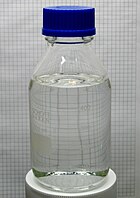Battery acid
|
|||
 |
|||
 |
|||
| Names | |||
|---|---|---|---|
|
IUPAC name
Sulfuric acid
|
|||
| Other names
Oil of vitriol
|
|||
| Identifiers | |||
|
3D model (Jmol)
|
|||
| ChEBI | |||
| ChemSpider | |||
| ECHA InfoCard | 100.028.763 | ||
| EC Number | 231-639-5 | ||
| E number | E513 (acidity regulators, ...) | ||
| 2122 | |||
| KEGG | |||
|
PubChem CID
|
|||
| RTECS number | WS5600000 | ||
| UNII | |||
| UN number | 1830 | ||
|
|||
|
|||
| Properties | |||
| H 2SO 4 |
|||
| Molar mass | 98.079 g/mol | ||
| Appearance | Clear, colorless liquid | ||
| Odor | odorless | ||
| Density | 1.84 g/cm3, liquid | ||
| Melting point | 10 °C (50 °F; 283 K) | ||
| Boiling point | 337 °C (639 °F; 610 K) When sulfuric acid is above 300 °C (572 °F), it will decompose slowly | ||
| miscible | |||
| Vapor pressure | 0.001 mmHg (20 °C) | ||
| Acidity (pKa) | −3, 1.99 | ||
| Viscosity | 26.7 cP (20 °C) | ||
| Thermochemistry | |||
|
Std molar
entropy (S |
157 J·mol−1·K−1 | ||
|
Std enthalpy of
formation (ΔfH |
−814 kJ·mol−1 | ||
| Hazards | |||
| Safety data sheet | External MSDS | ||
| GHS pictograms |  |
||
| GHS signal word | Danger | ||
| H314 | |||
| P260, P264, P280, P301+330+331, P303+361+353, P363, P304+340, P305+351+338, P310, P321, P310, P405, P501 | |||
|
EU classification (DSD)
|
|||
| R-phrases | R35 | ||
| S-phrases | (S1/2) S26 S30 S45 | ||
| NFPA 704 | |||
| Flash point | Non-flammable | ||
| 15 mg/m3 (IDLH), 1 mg/m3 (TWA), 2 mg/m3 (STEL) | |||
| Lethal dose or concentration (LD, LC): | |||
|
LD50 (median dose)
|
2140 mg/kg (rat, oral) | ||
|
LC50 (median concentration)
|
50 mg/m3 (guinea pig, 8 hr) 510 mg/m3 (rat, 2 hr) 320 mg/m3 (mouse, 2 hr) 18 mg/m3 (guinea pig) |
||
|
LCLo (lowest published)
|
87 mg/m3 (guinea pig, 2.75 hr) | ||
| US health exposure limits (NIOSH): | |||
|
PEL (Permissible)
|
TWA 1 mg/m3 | ||
|
REL (Recommended)
|
TWA 1 mg/m3 | ||
|
IDLH (Immediate danger)
|
15 mg/m3 | ||
| Related compounds | |||
|
Related strong acids
|
Selenic acid Hydrochloric acid Nitric acid Chromic acid |
||
|
Related compounds
|
Sulfurous acid Peroxymonosulfuric acid Sulfur trioxide Oleum |
||
|
Except where otherwise noted, data are given for materials in their standard state (at 25 °C [77 °F], 100 kPa).
|
|||
|
|
|||
| Infobox references | |||
Sulfuric acid (alternative spelling sulphuric acid) is a highly corrosive strong mineral acid with the molecular formula H2SO4 and molecular weight 98.079 g/mol. It is a pungent-ethereal, colorless to slightly yellow viscous liquid that is soluble in water at all concentrations. Sometimes, it is dyed dark brown during production to alert people to its hazards. The historical name of this acid is oil of vitriol.
Sulfuric acid is a diprotic acid and shows different properties depending upon its concentration. Its corrosiveness on other materials, like metals, living tissues or even stones, can be mainly ascribed to its strong acidic nature and, if concentrated, strong dehydrating and oxidizing properties. It is also hygroscopic, readily absorbing water vapour from the air. Sulfuric acid at a high concentration can cause very serious damage upon contact, since not only does it cause chemical burns via hydrolysis, but also secondary thermal burns through dehydration. It can lead to permanent blindness if splashed onto eyes and irreversible damage if swallowed.
...
Wikipedia



